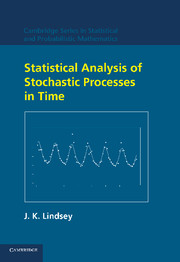Book contents
12 - Growth curves
Published online by Cambridge University Press: 03 February 2010
Summary
In certain stochastic systems, we cannot observe changes for individual elements but only in aggregation. For example, in a chemical reaction, we cannot observe the changes of state of the participating atoms but only the concentration of each reactant and product; in the growth of a biological organism, we cannot observe the addition of individual proteins, or even of cells, but only the increase in weight, length, or volume. In other words, records of change in such a system are averages of the stochastic changes of all the components involved.
Such systems can, nevertheless, generally be modelled mechanistically by rates of change of the individual elements, in ways similar to the intensity functions in Part 2. This procedure will yield some form of mean function for the aggregate change. However, a second level of stochastic variability usually also is present, resulting from random external influences on the system: changes in pressure or temperature of a chemical reaction, changes in food supply, stress, and so on, to a biological organism. Thus, modifications at the level of the individual components only can be modelled as a mean function, with variation about it arising from the second level of stochastic variability.
Here, and in Chapter 13, I shall look at some ways to model two of the most important types of such phenomena:
(i) in this chapter, processes where material is accumulating in a system;display
(ii) in the next, when the material is entering, passing through, and leaving a system.
In both cases, model construction will involve solving differential equations.
Characteristics
One special type of series recorded over time involves measurements related to growth of some kind.
- Type
- Chapter
- Information
- Statistical Analysis of Stochastic Processes in Time , pp. 268 - 284Publisher: Cambridge University PressPrint publication year: 2004
- 1
- Cited by

